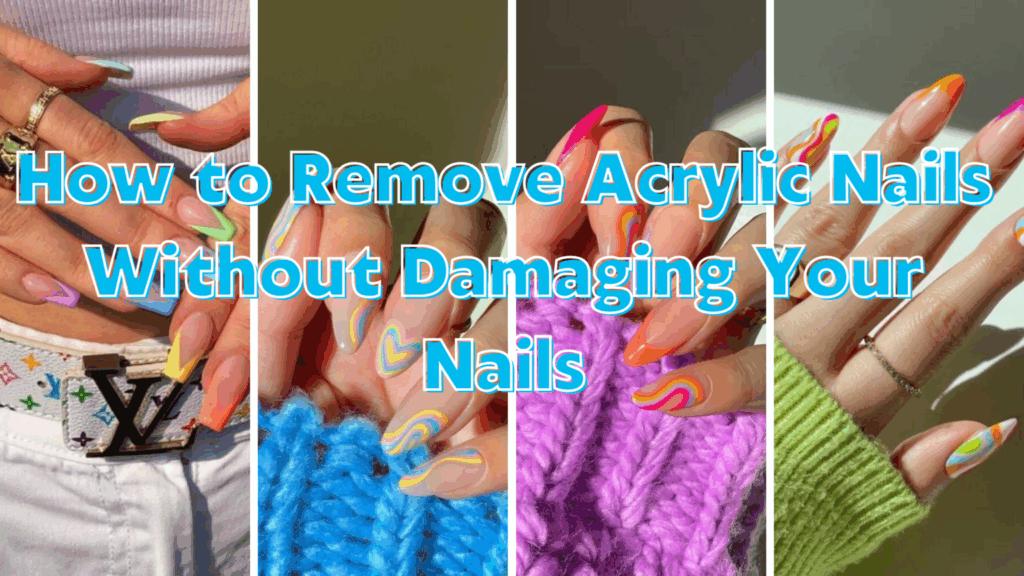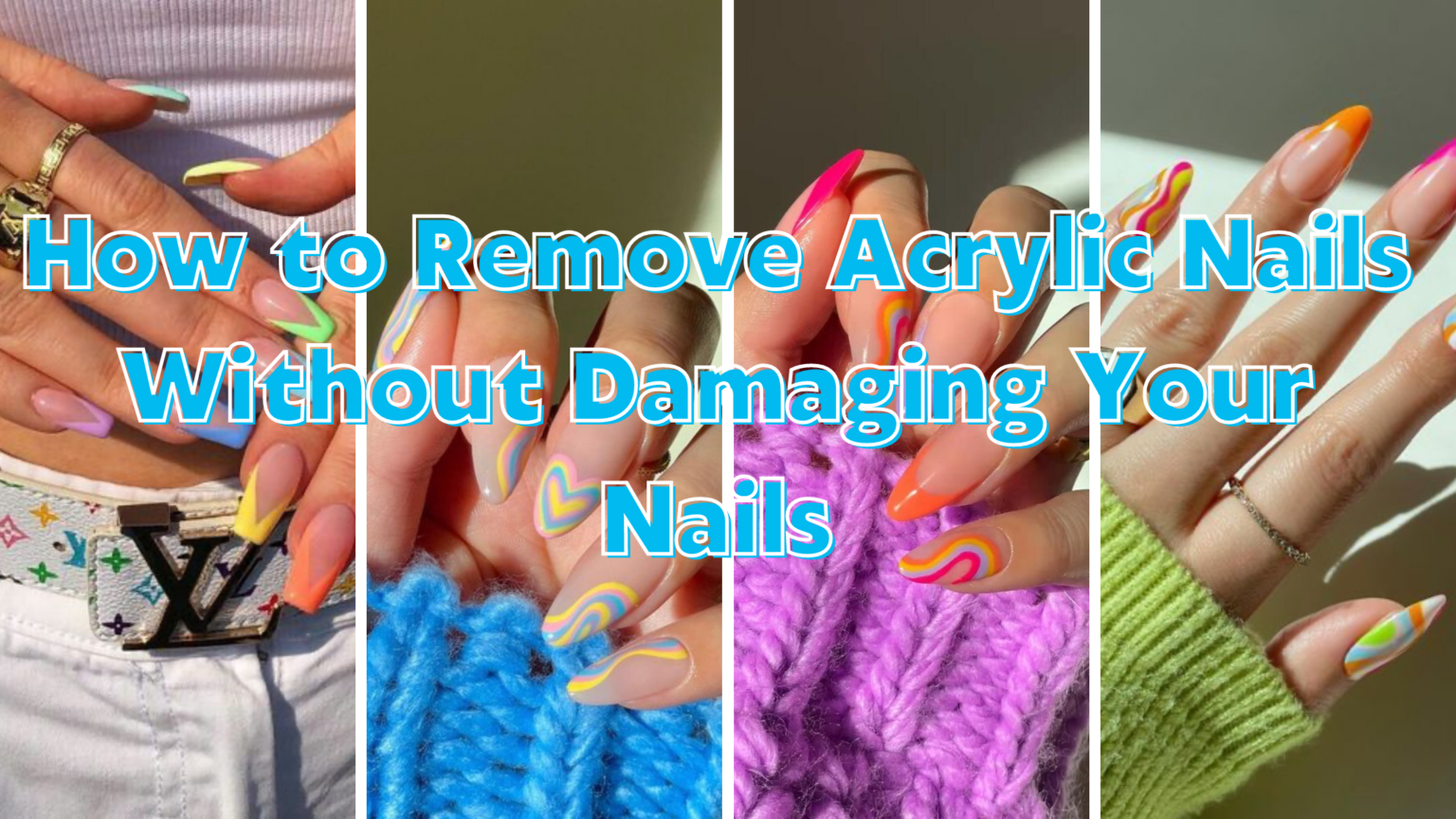
How to Remove Acrylic Nails Safely at Home: A Complete Guide
Struggling to remove your acrylic nails without damaging your natural nails? You’re not alone. Many people find the process challenging and often resort to picking or peeling, which can lead to weak, brittle nails. This comprehensive guide provides expert-backed methods and step-by-step instructions on how to remove acrylics safely, effectively, and without causing unnecessary harm. We’ll cover everything from understanding the science behind acrylics to choosing the right removal technique, ensuring you maintain healthy, beautiful nails.
Understanding Acrylic Nails and Their Removal
Before diving into the removal process, it’s crucial to understand what acrylic nails are and how they bond to your natural nails. Acrylic nails are a combination of a liquid monomer and a powder polymer that creates a hard, protective layer. This layer adheres strongly to the nail surface, making removal a delicate process.
The Science Behind Acrylic Adhesion
The adhesion of acrylic nails relies on a chemical bond. The acrylic mixture creates microscopic pores in the natural nail, allowing the acrylic to grip tightly. This bond is what makes acrylics durable, but it also means that simply pulling them off is a recipe for disaster.
Why Professional Removal is Often Recommended
While it’s always recommended to visit a professional nail technician to remove acrylics, it is not always feasible for everyone due to time constraints or budget limitations. This guide aims to provide you with the knowledge and skills to safely remove them at home, mimicking the techniques used by professionals.
Essential Tools and Materials for Acrylic Nail Removal
Having the right tools and materials is crucial for a successful and safe acrylic nail removal. Here’s a list of what you’ll need:
- 100% Acetone: This is the key ingredient for breaking down the acrylic. Make sure it’s pure acetone, not nail polish remover.
- Cotton Balls: For soaking the nails in acetone.
- Aluminum Foil: To wrap the cotton balls around each nail.
- Nail File (100/180 grit): To file down the top layer of the acrylic.
- Nail Buffer: To smooth out the nail surface after removal.
- Cuticle Pusher: To gently remove softened acrylic.
- Cuticle Oil: To moisturize and nourish the nails and cuticles.
- Warm Water: For soaking your fingers in a bowl.
- Small Bowl: To hold the acetone.
Step-by-Step Guide: The Acetone Soak Method
The acetone soak method is the most common and effective way to remove acrylic nails at home. Here’s a detailed breakdown of the process:
Step 1: File Down the Acrylic Surface
Using a coarse nail file (100/180 grit), gently file down the top layer of the acrylic. This helps the acetone penetrate more effectively. Be careful not to file too deeply into your natural nail.
Step 2: Protect the Surrounding Skin
Apply a thick layer of petroleum jelly or cuticle oil around your cuticles and the skin surrounding your nails. This will help protect your skin from the drying effects of acetone.
Step 3: Soak Cotton Balls in Acetone
Saturate cotton balls with 100% acetone. Make sure the cotton is fully soaked but not dripping.
Step 4: Apply Cotton Balls to Nails and Wrap with Foil
Place a soaked cotton ball directly on each nail and wrap it tightly with aluminum foil. This creates a sealed environment that helps the acetone break down the acrylic.
Step 5: Wait Patiently
Allow the acetone to soak for at least 20-30 minutes. The exact time will depend on the thickness of the acrylic. Check a nail after 20 minutes to see if the acrylic is softening.
Step 6: Gently Remove Softened Acrylic
After soaking, remove the foil and cotton balls. Use a cuticle pusher to gently scrape away the softened acrylic. If the acrylic is still hard, re-wrap the nail with acetone and foil for another 10-15 minutes.
Step 7: Buff and Smooth the Nail Surface
Once all the acrylic is removed, use a nail buffer to smooth out any remaining residue and even out the nail surface.
Step 8: Hydrate and Nourish Your Nails
Acetone can be very drying, so it’s essential to rehydrate your nails and cuticles. Apply a generous amount of cuticle oil and hand cream to restore moisture.
Alternative Methods for Removing Acrylic Nails
While the acetone soak method is the most effective, there are alternative approaches you can try. These methods may be less effective or take longer, but they can be useful if you’re sensitive to acetone.
The Warm Water Soak Method
This method involves soaking your nails in warm, soapy water for an extended period. While less effective than acetone, it can help loosen the acrylic.
- File down the top layer of the acrylic.
- Soak your fingers in a bowl of warm, soapy water for 30-45 minutes.
- Gently use a cuticle pusher to lift the edges of the acrylic.
- Repeat the soaking and pushing process until the acrylic is removed.
Using a Nail Drill
A nail drill can be used to carefully file down the acrylic. However, this method requires skill and caution to avoid damaging the natural nail. It’s best left to professionals or those with experience using nail drills.
Common Mistakes to Avoid When Removing Acrylic Nails
Removing acrylic nails can be tricky, and it’s easy to make mistakes that can damage your natural nails. Here are some common pitfalls to avoid:
- Picking or Peeling: This is the worst thing you can do, as it can tear off layers of your natural nail.
- Using Force: Never force the acrylic off. If it’s not coming off easily, soak it longer.
- Filing Too Deeply: Be careful not to file into your natural nail when filing down the acrylic.
- Not Protecting the Skin: Acetone can dry out and irritate the skin, so always protect your cuticles and surrounding skin.
- Skipping Hydration: Rehydrating your nails and cuticles is essential after acetone exposure.
How to Care for Your Nails After Acrylic Removal
After removing acrylic nails, your natural nails may be weak, thin, and brittle. Proper care is essential to restore their health and strength.
Hydrate Regularly
Apply cuticle oil and hand cream several times a day to keep your nails and cuticles moisturized.
Strengthen Your Nails
Use a nail strengthener or hardener to help rebuild the keratin in your nails.
Protect Your Nails
Wear gloves when doing household chores or working with your hands to protect your nails from damage.
Maintain a Healthy Diet
A balanced diet rich in vitamins and minerals can help promote healthy nail growth.
Product Spotlight: Cuticle Oils for Nail Recovery
Cuticle oil is a vital product for maintaining healthy nails, especially after acrylic removal. It nourishes and hydrates the cuticles and nail bed, promoting strong and healthy nail growth. There are many cuticle oils available, each with unique ingredients and benefits.
Key Ingredients in Cuticle Oils
Common ingredients in cuticle oils include:
- Jojoba Oil: Mimics the skin’s natural oils, providing deep hydration.
- Almond Oil: Rich in vitamins and minerals, promoting nail strength.
- Vitamin E: An antioxidant that helps protect against damage.
- Apricot Kernel Oil: Lightweight and easily absorbed, nourishing the cuticles.
How to Apply Cuticle Oil
Apply cuticle oil to your cuticles and nail bed several times a day. Massage it in gently to promote circulation and absorption.
Benefits of Using Cuticle Oil After Acrylic Removal
Using cuticle oil after acrylic removal offers several key benefits:
- Hydration: Replenishes moisture lost during the acetone soak.
- Nourishment: Provides essential vitamins and minerals to promote nail health.
- Protection: Creates a barrier against environmental damage.
- Strength: Helps rebuild the keratin in your nails, making them stronger.
- Growth: Stimulates healthy nail growth.
Comprehensive Review: OPI ProSpa Nail & Cuticle Oil
The OPI ProSpa Nail & Cuticle Oil is a popular and highly-rated product for nail and cuticle care. It’s formulated with a blend of cupuaçu butter, avocado lipid complex, white tea extract, and kukui nut oil to provide intense hydration and nourishment.
User Experience & Usability
The OPI ProSpa Nail & Cuticle Oil is easy to apply with its convenient brush applicator. The oil absorbs quickly and doesn’t leave a greasy residue. Users report that their nails and cuticles feel instantly hydrated and nourished.
Performance & Effectiveness
This cuticle oil delivers on its promises. It effectively hydrates and nourishes the nails and cuticles, promoting strength and growth. Regular use can significantly improve the health and appearance of your nails.
Pros
- Intense hydration and nourishment
- Quick absorption
- Non-greasy formula
- Easy to apply
- Pleasant scent
Cons/Limitations
- Relatively expensive compared to other cuticle oils
- Some users may find the scent overpowering
- Availability may be limited
Ideal User Profile
The OPI ProSpa Nail & Cuticle Oil is ideal for anyone looking to improve the health and appearance of their nails and cuticles. It’s especially beneficial for those who frequently get acrylic nails or experience dry, brittle nails.
Key Alternatives
Alternatives to the OPI ProSpa Nail & Cuticle Oil include:
- CND SolarOil
- Essie Apricot Cuticle Oil
Expert Overall Verdict & Recommendation
The OPI ProSpa Nail & Cuticle Oil is a top-tier product that delivers excellent results. While it may be more expensive than other options, its high-quality ingredients and effective formula make it worth the investment. We highly recommend it for anyone serious about nail care.
Q&A: Expert Answers to Your Acrylic Nail Removal Questions
- Q: How long should I soak my nails in acetone?
- A: Typically, 20-30 minutes is sufficient, but it depends on the thickness of the acrylic. Check after 20 minutes and re-wrap if needed.
- Q: Can I use nail polish remover instead of acetone?
- A: Nail polish remover is less effective and may not fully dissolve the acrylic. 100% acetone is recommended for best results.
- Q: How can I prevent damage to my natural nails during removal?
- A: Avoid picking or peeling, file gently, protect your skin with petroleum jelly, and hydrate your nails after removal.
- Q: Is it safe to use a nail drill to remove acrylics at home?
- A: Using a nail drill requires skill and caution. It’s best left to professionals to avoid damaging the natural nail.
- Q: How often should I apply cuticle oil after acrylic removal?
- A: Apply cuticle oil several times a day to keep your nails and cuticles moisturized and nourished.
- Q: What are the best ingredients to look for in a cuticle oil?
- A: Look for oils rich in jojoba oil, almond oil, vitamin E, and apricot kernel oil.
- Q: How can I strengthen my nails after acrylic removal?
- A: Use a nail strengthener or hardener to help rebuild the keratin in your nails.
- Q: Can I use a warm water soak to remove acrylics if I’m sensitive to acetone?
- A: Yes, the warm water soak method is a gentler alternative, but it may take longer and be less effective.
- Q: How do I know if the acrylic is softened enough to remove?
- A: The acrylic should be soft and gummy, easily scraping off with a cuticle pusher.
- Q: What should I do if my nails are still weak and brittle after a few weeks of care?
- A: Consult a dermatologist or nail technician for professional advice and treatment options.
Conclusion: Safe and Effective Acrylic Nail Removal at Home
Removing acrylic nails at home can be a safe and effective process if done correctly. By following the steps outlined in this guide and using the right tools and products, you can remove your acrylics without damaging your natural nails. Remember to be patient, gentle, and prioritize the health of your nails. Proper aftercare is essential to restore their strength and beauty. Share your experiences with how to remove acrylics in the comments below, and explore our other guides for more nail care tips.

